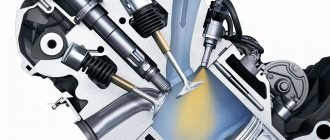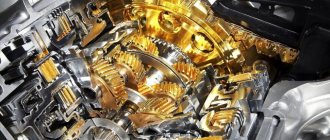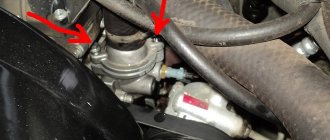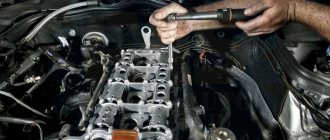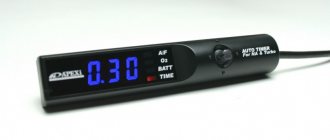Disputes about whether or not to warm up a car engine before a trip do not subside among car enthusiasts. Is warming up really necessary? If so, what is the best way to do it? Is it necessary to warm up the engine in summer? Or only in winter? What are the risks of driving on a cold engine? Let's try to figure it out.
The majority of car enthusiasts claim that it is necessary to warm up the car engine before driving. But, on the contrary, the instructions for modern cars state the opposite. And to be completely precise, they suggest a method for warming up the engine “on the go”, and it is specifically stipulated that warming up the engine “the old fashioned way” while idling is not recommended.
Do I need to warm up the engine before driving?
Today there is a lot of controversy about this, but no consensus has emerged on this matter.
Even 15–20 years ago, the answer to the question was clear: yes, it is necessary to warm up the engine. And both in winter and in summer. Unheated cars sneezed, coughed, stalled, or refused to start at all.
But with the advent of more modern cars, motorists en masse refuse to warm up the engine. Moreover: in many European countries, warming up the engine while parked is strictly prohibited by law.
As we all know, the power plant of a car is a kind of its heart, the service life of which directly depends on a large number of indicators, frequency of maintenance and operating rules. Today’s topic is dedicated to those car enthusiasts who don’t know what to do before starting to drive their car, whether it’s worth warming up the engine and how long it should take? For reference, we note that today the number of supporters and opponents of engine warming up is almost equal. Some people refer to the technical documentation for the car, while others adhere to the old-fashioned rules for operating the car. Who is right in this situation? What is the right thing to do so as not to harm the car engine? We will analyze these questions in our article in order to forever remember how competently you need to start a train in your car in winter, as well as in summer.
Most modern automakers have increasingly begun to indicate in the vehicle manual that there is no need to warm up the engine, and that all engines now do not require this procedure. In addition, manufacturers believe that warming up the power plant is just unnecessary fuel consumption and environmental pollution, because engines emit exhaust gases into the atmosphere, which lead to greenhouse effects, as well as the appearance of ozone holes. But is it
? That is, it turns out that if we want to start a trip in twenty-degree frost, we don’t need to warm up the engine even for the same 30 seconds? Can motor oil really immediately become optimally viscous and turn from thick to liquid, which will be suitable for driving? However, as a rule, there are simply no clear answers to these questions in the documentation for the car. It only says that we need to take care of the environment, “our mother.”
For reference, we note that if we buy a car in Europe (starting from Poland, the Baltic states and further west), in the technical documentation for the car there will be a sign of crossed out exhaust gases, which indicates concern for the environment, that is, heating the engine is evil for nature . However, as we noted earlier, why didn’t anyone think about the engine, but is it good or bad? To find out, we must analyze the positive and negative aspects that exist for the power plant from warming up.
It's better to go than to stand
For some reason, many motorists claim that automakers allow the engine not to warm up. This is fundamentally wrong. They require warming up the engine, but not while parked, but while driving at low loads and at relatively low speeds, without sudden acceleration in the first minutes of the trip. This is necessary because during a trip the engine reaches operating temperatures faster. In addition, it emits less harmful substances.
Don't get cocky. How to properly start a car engine after idle time? More details
Thanks to environmental protection programs for the government of many countries, Euro 5 and Euro 6 standards are being introduced, and cars are becoming less harmful to humans. However, when idling after a cold start, increased emissions of harmful substances are still observed. If you stand under the windows of the house and wait until the power unit reaches operating temperature, then neighbors on the first floors may begin to complain about the unpleasant smell of exhaust gases. Therefore, manufacturers instruct not to stand, but to hit the road and warm up the car while driving.
Engine oil:
It is the most important technical fluid of any car, which ensures optimal lubrication of rubbing parts in the power plant. However, in order for the oil to perform its main functions, it must be in a liquid and heated state. When we turn off the engine, the oil always flows into the sump and remains there until the next time the engine is started. Thus, the technical fluid drains from the walls of the parts, leaving their surface almost dry.
In connection with the above, we note that when we start the engine, it is highly not recommended to even lightly press the gas pedal for at least 10-15 seconds, not to mention starting to move. The fact is that in the first seconds after starting the engine, oil begins to rise through the channels from the sump to the top of the system, thereby filling all the cavities of the power plant in order to effectively lubricate the cylinder-piston group ( pistons
,
cylinders
,
camshaft
,
crankshaft
,
valves
and other elements).
If we consider the winter season, the situation here is even more complicated for oil, since under the influence of low temperatures, the liquid becomes thick. In order for the oil to become liquid, a positive temperature is necessary. And without heating the engine there is no way to achieve this. So much for caring for nature. For reference, we note that thick oil is similar in consistency to glue and if it is not heated, the wear of engine components will occur at an accelerated pace, since the lubrication of parts will not occur effectively.
Warming up process: how does it happen?
All components of the car's power unit are made of metal. When heated, the cylinders, pistons and other components of the engine expand. The heating time directly depends on the material of manufacture. Each of them is configured in such a way that the gap between the piston and cylinder is as minimal as possible. Only in this case, the energy loss at the moment of ignition of the fuel mixture is negligible. Therefore, until the car parts warm up and expand accordingly, the car essentially does not work fully. Moreover, the cylinders and pistons experience greater loads and are subject to greater wear.
What to do in winter: should you warm it up or not?
Warming up the engine in winter is considered a mandatory procedure that should never be ignored. Especially if there is sub-zero temperature outside and a huge amount of snow. The operating principle of the engine is based on the interaction of a combustible mixture with a spark, which provokes a further explosion. As a result, the pressure in the cylinders increases and the piston begins to move, thereby ensuring the rotation of the wheels. This whole process is accompanied by high temperatures and friction, which consequently leads to rapid wear of car parts. To reduce wear in winter, all surfaces exposed to friction are lubricated with oil. And since winter temperatures are low, the oil quickly thickens and does not provide the full effect.
Watch a video about warming up a car in the winter:
Source
Compression and oil scraper rings
These elements of the power plant are located in special grooves on the pistons. Oil scraper rings are needed to remove excess oil from the cylinder walls, and compression elements are needed for compression. These two types of rings are located next to each other. The rings are rubbing parts; their friction occurs against the surface of the cylinder. In addition, they take on powerful impact loads. Now it’s worth remembering my school years and a subject called physics. It says there that all metal parts expand when heated. As for the engine, the same cylinder block is made of metal, therefore the cylinders located in it expand by several microns when heated, and when cooled they narrow back by the same amount.
Thus, when the power plant is not warmed up, the cylinders compress the rings more strongly. When the engine starts, it becomes more difficult for the rings in this state to move up and down the plane of the cylinder. After the inner surface of the cylinder block is heated, the metal expands and the oil thereby begins to lubricate the cavity with the parts much more effectively, so the movement of the rubbing elements becomes easier.
Therefore, immediately after starting, the engine initially increases speed, and then after a short time interval it smoothly reduces it. When the speed of the power plant decreases, this indicates that the surface of the cylinders and parts has been brought to a heated state. Consequently, it becomes easier for the motor to work, the load on it gradually decreases. Thus, the situation described above is another reason to warm up the power unit. Thanks to warming up, we seem to unload and remove excessive load from the cylinder-piston group.
Fuel and oil in the combustion chamber.
In a cold engine, a fuel-air mixture of worse quality is formed, since gasoline evaporates less well (and it is gasoline vapor mixed with air that burns). Smart electronics compensate for this with a larger amount of injected gasoline (relative to the amount of air), so to speak, “enriches” the mixture. At the same time, in an unheated combustion chamber, gasoline may not burn completely, especially when there is more of it than at normal operating temperature. Unburnt fuel flies out with the exhaust, but if at this moment you increase the crankshaft speed (i.e., press the gas and drive), then, firstly, there will be even less time for gasoline to burn, and secondly, the increased pressure, coupled with With unselected thermal gaps, the CPG will be able to push gasoline into the crankcase, where it will immediately begin to deteriorate the oil. Somewhere I came across complaints that, supposedly, gasoline washes away oil from the walls of the combustion chamber... Damn, it shouldn’t be there, then why are oil scraper rings needed? And if it is there, it will still burn, since the temperature in the combustion chamber is much higher than the ignition temperature of ordinary oil.
Oil filter
Just like the previously described units, they need to be warmed up, especially in the winter months. The fact is that the oil filter only at first glance seems to be a simple consumable item, which consists of special paper wrapped in a metal case, but this is deeply misleading. In the case when engine oil passes through a good filter, then all the dirt that is present in the technical fluid remains in the filter element. This cleanses the oil, which continues to circulate through the engine system. Thus, all metal shavings with wear elements settle on the filter paper and do not pass further.
When the engine is not warmed up, the oil becomes thick and simply cannot pass through the filter paper of the consumable element properly. Therefore, when the car is moving with a cold engine, a bypass valve opens in the filter and the technical fluid, bypassing the filter element, is sent from the pan directly to the engine, carrying wear products. For reference, we note that engine oil becomes liquid only after the power plant warms up to 65-70 degrees Celsius. At this temperature, the technical fluid is able to optimally penetrate the filter paper and thus the bypass valve does not open. Thus, cold oil with dirt goes directly into the engine, and by starting a trip without warming up, we simply accelerate the wear of our engine.
Hydraulic tensioner and hydraulic compensators
Used to adjust valve operation and chain tension. These devices are designed to pump engine oil into the system and ensure optimal tension of the drive chain of the gas distribution mechanism, that is, they align the operation of the valves. When unheated oil enters the engine, adjustment of the required clearances in the system is not carried out effectively. Therefore, the engine must be warmed up so that the oil becomes elastic and fluid. This problem is especially noticeable in severe frost, because the chain begins to rattle and the valves begin to tap. In general, there’s nothing to even think about here; it’s better to warm up the engine than to run into a situation where the chain jumps over a gear tooth, which will lead to expensive engine repairs.
Relation of diesel and injector to preheating
Why is it necessary to warm up a diesel engine and how is it done? The peculiarity of these units is smooth operation even in cold conditions. A diesel car starts without problems and often behaves perfectly, but lack of warming up will have a bad effect on its parts. Excessive stress will arise and wear will increase, so that very soon the question of repair or complete replacement of the diesel engine will arise.
The warm-up time is from 3 to 5 minutes at idle. But avoid a lengthy procedure, otherwise carbon deposits and resin deposits will form on the surface of the parts. Turbocharged engines should be allowed to idle for at least 1-2 minutes. This will reduce the depreciation of the turbine.
Engine oil sensor
For modern cars, it is made of plastic and serves to measure the density of technical fluid in the system. When the engine is not warmed up, the power plant simply squeezes them out due to the thick technical fluid. When the sensor is squeezed out, oil begins to come out from under it and then drip out, which is already a problem for the engine and the car owner. After the oil leaks from the sensor, it begins to signal on the dashboard with a corresponding indicator that the technician has low pressure of the fluid in the sump. Once we start warming up the engine longer, this problem often goes away.
Thus, as we see, driving on a cold car engine does not bring any positive aspects for the components of the power plant. In addition, driving on a “cold” engine can cause increased oil and fuel consumption, and also has a detrimental effect on the environment in the form of carbon dioxide emissions. But the most important problem with systematically not warming up the engine is the rapid wear of engine parts, which quickly leads the power plant to overhaul.
Why doesn't the engine start or starts reluctantly?
The question of whether it is necessary to warm up the engines can be considered settled. However, very often we encounter problems even after this operation. Sometimes an already warmed-up engine will not start, and the reason for this may be overheating, as a result of which the antifreeze temperature sensor or the booster pump of the cooling system fails.
Antifreeze temperature sensor failure
There may also be a coolant leak and a decrease in compression in the cylinders. Then the engine will stall while driving, and then it will be very difficult to start. Be sure to check the coolant level and add it if necessary. Next, slowly, so as not to overload the power unit, get to the service station, where specialists will diagnose and eliminate any malfunctions that have arisen.
It also happens that a well-warmed engine does not start well after a short stop; it is often called “hot”. This phenomenon has a very logical explanation. While driving, the temperature of the carburetor is much lower than that of the engine, since a powerful air flow passes through the former and cools it. After you turn off the ignition, the engine intensively transfers its heat to the carburetor, which leads to boiling and evaporation of gasoline. The result is an enriched mixture, possibly even the formation of vapor locks.
Boiling and evaporation of gasoline
When you open the throttle, the mixture returns to normal. Therefore, starting a “hot” engine is fundamentally different; in this case, you can even press the gas pedal to the floor. After the engine is in working condition, do a few more gas cycles, this way you will normalize the combustible mixture as quickly as possible. In some cases, this mainly concerns the product of the domestic automobile industry, such a launch may not produce results. Be sure to check the fuel pump and, if necessary, force cool it, for example, by pouring water. Did it help? Be sure to replace the gasoline pump with a new one soon.
RULES AND RECOMMENDATIONS FOR WARMING UP A CAR ENGINE
Now we know that warming up the engine is not advisable, but mandatory, and this must be done constantly. However, this must be done without fanaticism, since sometimes overheating is worse than warming up. In addition, as we remember, there are two seasons: winter and summer. Regarding this or that couple of years, there are certain engine warm-up modes, which we will now analyze.
For example, in winter, when the outside temperature is from -10 to -20 degrees Celsius, warming up the engine before driving should be done for about 8-12 minutes, this is quite enough. When the outside temperature is from -20 to -30 degrees Celsius, warming up the engine before driving should take about 12-15 minutes, and if we are in a hurry, we can reduce the time period to 10 minutes. The image below clearly shows a reminder to car enthusiasts, which demonstrates the rules for warming up a car in cold weather (CLICK ON IMAGE TO ENLARGE).
As for the summer couple of the year, you should not warm up the engine for more than 5 minutes .
If the outside temperature is
+15-30 degrees
Celsius, then the optimal time for warming up the engine is considered to be
2-3 minutes
, since this is enough for the oil to spread along the cylinder walls and the lubricant to begin functioning fully.
If the outside temperature is above +30 degrees
Celsius, then
1-2 minutes
. Thus, as we can see, even in hot weather it is highly not recommended to start driving the car immediately after starting the engine.
Very often you can hear the assertion of some car enthusiasts that you can start driving a car as soon as the engine speed on the tachometer begins to fall. Yes, indeed, this indicator, to some extent, characterizes the fact that the load on the cylinder-piston group has decreased and the system has warmed up a little. In principle, as specialists in the maintenance and repair of vehicles recommend, regarding the summer couple of the year, you can, in principle, start driving the car. However, this option is not appropriate for winter. In winter, it is better to warm up the engine based on time, not speed. We must understand that during the warm-up of the power plant, not only the cylinders must heat up, but also all the main components of the engine, for example, shafts, connecting rods, pistons, hydraulic compensators and other parts. In addition, we must not forget about the transmission, especially if it is automatic or CVT, since it also needs to be warmed up.
What is there to warm up a little?
Modern automakers care little about what happens to the engine when it reaches its guaranteed mileage. As mentioned above, sudden accelerations are undesirable for a cold engine. Agree, when you drive out onto the road, it is not known for certain how the situation will turn out: perhaps at some point you will need to overtake or accelerate sharply.
“I go out, in the morning everything is covered with snow, the car is not even visible. I took a scraper and cleared the snow from the car for almost an hour,” a message like this was once left by a car enthusiast on a well-known automobile forum. Of course, heavy snow does not fall every day in winter, but the routine of preparing a car for a trip in the cold season is similar for most drivers. When going out to the car in snowy winter weather, an experienced driver will take a brush or shovel, and sometimes both, to clear the car and windows of snow. Before that, he will probably turn on the heated windows, mirrors and seats, if, of course, the equipment allows it. Of course, this procedure takes some time - usually no more than 2-5 minutes. A simple solution can be suggested: while you are cleaning and preparing the car for a trip, you can start it and let it run, but no more than 5 minutes.
An engine that has been preheated (but without fanaticism!) will be subject to less wear in cases where road conditions may require increased load on the engine. Do not forget that slipping is possible on a slippery road in uncleared local areas, which immediately leads to a significant increase in engine speed.
We recommend: Types of additives for restoring an internal combustion engine
The following recommendations can be offered:
- at a temperature of about 0°C, the engine does not need to be warmed up or the warming up should be minimal, no more than a minute of idling;
- at an outside temperature of about -10°C, a minimum warm-up is allowed - up to two minutes, which is also important for warming up frozen car windows, otherwise the trip may be unsafe;
- at temperatures within -20°C, you can warm up the engine for up to five minutes, including to allow the car windows to defrost properly and prepare the heater for operation.
It is clear that at low temperatures, after 2-3 minutes of engine operation, you need to remember to turn on the heater - and the windows will not freeze and the interior will warm up more quickly.
In order not to wait in the parking lot while the stove and windows warm up, many owners equip their cars with the Webasto system - it allows you to start the engine from home.
Typically, reaching the operating temperature of the engine starts at about 50 degrees, and the recommended temperature for operating the engine in various modes is about 80-90 degrees.
How long does it take to warm up the engine?
Perhaps this is the most appropriate question. After all, we have already come to the conclusion that it is necessary to warm up the engine in almost any case. All that remains is to understand how long the warm-up should take.
So, you can follow the hint:
Engine warm-up time in winter and summer
| +15 C | 1 - 2 minutes |
| +10 C | 1.5 - 3 minutes |
| +5 C | 2.5 - 5 minutes |
| 0 C | 3 - 7 minutes |
| -5 C | 3.5 - 8 minutes |
| -10 C | 5 - 10 minutes |
| -15 C | 8 - 15 minutes |
As you can see, in the summer, warming up takes very little time.
You only have time to get comfortable in your seat, fasten your seat belt, adjust the mirrors and turn on your favorite radio channel. In winter, the recommended time for warming up the car is longer, but while your car is warming up, you can slowly clear the snow from the body, clear the wipers of ice, and warm up the windshield.
There is no need to wait until it warms up completely. As soon as the temperature of the working fluid rises to 60-70 degrees, you can carefully start moving. But it would still be more correct to accelerate when the fluid temperature reaches 80-90 degrees Celsius.
Injection engine in winter
In injection engines, the issue of suction does not arise, since the automation itself sets the necessary parameters taking into account the temperature, namely, the mixture is ignited early, after which fuel is supplied
gradually increases. Despite the fact that the process in an injection engine occurs automatically, some actions are also required on the part of the driver. To quickly start an injection engine, two conditions are necessary - a good spark and a sufficient amount of fuel. The battery is responsible for everything. Thus, in frosty weather, it is considered good manners to turn on the headlights for half a minute, which will warm up the battery electrolyte and ensure maximum current output. And when starting an injection engine without warming up, it is necessary to turn off all unnecessary electrical appliances, squeeze the clutch and only then start the engine. If this is done, then the machine sets all the settings and you can slowly start moving. To be fair, it should be noted that the latter is true for a manual transmission.
Why can't you warm up the engine for too long?
As we said above, everything needs moderation. It is also impossible to warm up the engine for too long.
The fact is that at low temperatures the fuel mixture evaporates poorly, so a car with electronic fuel injection immediately generates a command to release an additional portion of fuel.
But the car remains in place. And it turns out that at idle, excess gasoline is formed in the combustion chamber. Gasoline, in turn, causes the engine oil to wash out, that is, in fact, it leaves the engine without protection. Gasoline, as we know, is an excellent solvent.
However, if you do not delay warming up, nothing like this happens, and premature engine destruction does not occur.
Is it necessary to warm up the car in winter - conclusions
In some countries, there are laws prohibiting long periods of stopping while the engine is running to avoid high emissions into the atmosphere. Therefore, you need to be very careful with such heating, especially in large residential complexes.
However, if you live in a harsh climate zone, warming up may simply become a daily necessity for you. As standard, the rules limit the time of such parking to five minutes - for many cars this time will be more than enough.
Installing additional equipment can make the warm-up procedure easier. Such mechanisms will be useful for gasoline and diesel engines; manufacturers offer a large selection of such products. Therefore, each car owner chooses heating options for himself.
Warm up on the go
Recently, warming up the engine while driving, that is, in the first minutes of moving the car, has become very popular. You simply pull away smoothly and slowly (at low speeds) drive out of the yard or garage. At the same time, it is desirable that the road be as smooth as possible, because during warm-up jerks and jolts are undesirable.
While driving, the engine warms up faster, but experiences increased loads and consumes more fuel.
This method has one drawback: no matter how you look at it, the movement starts with a cold engine, which means the load on the mechanism is greater (remember the gaps and viscosity of working fluids). In addition, the gearbox also needs preheating, and without it, gearbox parts undergo accelerated wear, the oil wears out faster and produces sediment.
The ideal option: run the engine in idle mode for a couple of minutes (twice as long in winter), and then start moving smoothly at low speeds.
To warm up or not
The main rule, according to experienced car owners, is to wait until the engine speed drops to idle, after which you can begin a soft start. At the same time, you need to make sure that the revolutions do not go up: for diesel engines this figure is no more than 1500, for gasoline engines – no more than 2000 revolutions.
If your car is started in severe frosts (minus 20-30 degrees Celsius). The engine will still have to be slightly warmed up until the coolant temperature increases (50-60 degrees).
Warming up for too long will not be of much use - if there is no movement, you can only warm up the engine. And not in the most optimal way. The remaining components of the car (gearbox, axles, gearbox, dampers, as well as gaskets, tires, etc.) will still not be warmed up. It is possible to warm up these units only during soft driving at low speed, so wear on the units will be minimal.
These rules are suitable primarily for gasoline engines, since in severe frosts it is almost impossible to warm up a diesel engine. Autonomous heaters are designed for this, which operate from an additional energy source, such as a battery, mains, etc. The best option for warming up a diesel engine is to drive the car at low speed.
What are the dangers of warming up the engine?
Many people are afraid to warm up the engine due to a number of complications caused by this procedure. The disadvantages of warming up usually include:
- increased gasoline consumption;
- formation of resin deposits on valves;
- washing out oil with gasoline.
Oil leaching is especially dangerous. The piston rings and cylinder walls are primarily affected by this. However, it has been proven that all these shortcomings appear only in cases where there is chronic prolonged warming up of the engine.
During moderate warm-up, nothing happens to the engine that could significantly impair its performance.
Let's get started
You need to warm it up to operating temperature, or if you own a normal foreign car, the warm-up time should not exceed 1.5 minutes. Particularly smart people write that at -30 degrees, warming up should generally last at least 8 minutes, but believe me, during this time the engine will experience extreme overloads. And with such cold, you will want to turn on the stove, therefore the heat will go into the cabin and the heating time will increase by 1-3 minutes.
Only the VAZ 2107 is not a pity to use like this, and after 2 years of such use a normal foreign car will wish you a long and happy life.
But in most cases everything is individual. It is necessary to warm up not only the engine itself, but also the transmission. This primarily applies to cars with automatic transmissions, robotic and CVT gearboxes.
Important fact:
At idle, not every engine can warm up, especially a turbocharged engine.
Now let's approach this issue from the other side, why automakers directly write in the instructions that this is not necessary to do with the engine.
- 1. Due to the environment (yes, everyone in Europe is obsessed), a running car emits significantly more substances into the air compared to a car that starts immediately after turning the key;
- 2. Modern engines are already designed for a quick start and are made more reliably technologically (after all, it’s 2015). By the way, this is why new foreign cars do not have engine temperature sensors, there are only 3 types of notifications about the state of the engine - cold, good to go and overheating;
- 3. Some brands install a power limiting valve in their units, its essence lies in preventing damage to parts during a cold start. The engine itself will warm up while you drive around the city.
This is interesting: How to turn off the jack mode of Starline a91
